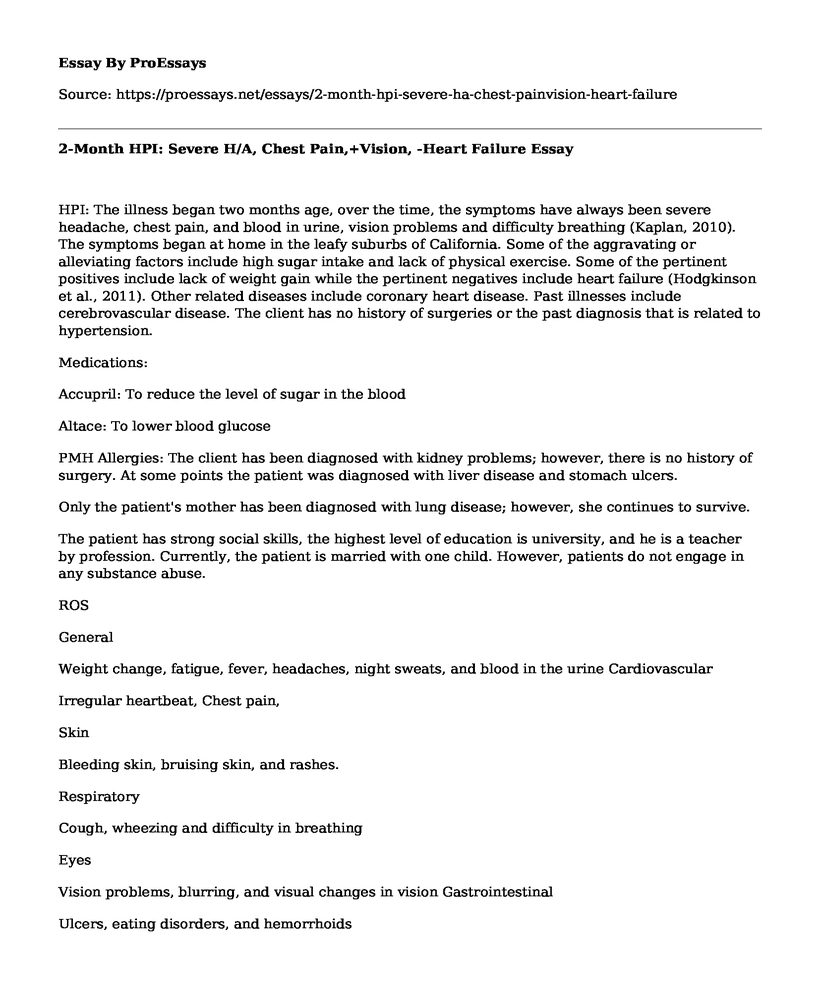HPI: The illness began two months age, over the time, the symptoms have always been severe headache, chest pain, and blood in urine, vision problems and difficulty breathing (Kaplan, 2010). The symptoms began at home in the leafy suburbs of California. Some of the aggravating or alleviating factors include high sugar intake and lack of physical exercise. Some of the pertinent positives include lack of weight gain while the pertinent negatives include heart failure (Hodgkinson et al., 2011). Other related diseases include coronary heart disease. Past illnesses include cerebrovascular disease. The client has no history of surgeries or the past diagnosis that is related to hypertension.
Medications:
Accupril: To reduce the level of sugar in the blood
Altace: To lower blood glucose
PMH Allergies: The client has been diagnosed with kidney problems; however, there is no history of surgery. At some points the patient was diagnosed with liver disease and stomach ulcers.
Only the patient's mother has been diagnosed with lung disease; however, she continues to survive.
The patient has strong social skills, the highest level of education is university, and he is a teacher by profession. Currently, the patient is married with one child. However, patients do not engage in any substance abuse.
ROS
General
Weight change, fatigue, fever, headaches, night sweats, and blood in the urine Cardiovascular
Irregular heartbeat, Chest pain,
Skin
Bleeding skin, bruising skin, and rashes.
Respiratory
Cough, wheezing and difficulty in breathing
Eyes
Vision problems, blurring, and visual changes in vision Gastrointestinal
Ulcers, eating disorders, and hemorrhoids
Ears
Discharge in ears, and hearing loss
Genitourinary/Gynecological
Frequency burning, change in color of urine. Contraception, sexual activity, STDs Male: prostate, PSA, urinary complaints
Nose/Mouth/Throat
Frequent nose bleeding, throat pain and dysphagia.
Musculoskeletal
Muscular pain, pain in the joints, and back pain.
Breast
No changes observed Neurological
Weakness and syncope
Heme/Lymph/Endo
Swollen glands and night sweats Psychiatric
Depression, anxiety, sleeping difficulties, suicidal ideation/attempts, and previous dx
Objective
Weight : 65kg BMI: 26.4 Temp: 37 BP: 160/90mmhg
Height: 160cm Pulse: 65bpm Resp: 12bpm
General Appearance
Healthy, strong, but pale yellow skin color.
Skin
Skin is brown, warm, dry, clean, and intact. No rashes or lesions noted.
HEENT
Head is atraumatic and lacks lesions; there is an equal distribution of hair. Eyes are normal and are intact. Ears have canals patent. Nose have normal turbinates; there is lack of septal deviation (Familoni, Ogun, & Aina, 2004). The neck has no cervical lymphadenopathy, in addition, there are no occipital nodes. Teeth or normal and are in good conditions.
Cardiovascular
There normal breathing with a regular rate of rhythm. Also, there is rubbing of the ribs and normal pulse rate.
Respiratory
There is a difficulty in the respiratory processes; the respiratory system is not regular and easy.
Gastrointestinal
Abdomen obese; BS active in all the four quadrants. Abdomen soft, non-tender. No hepatosplenomegaly
Breast
Breasts are in normal conditions
Genitourinary
In the genital parts, there is normal distribution of hair, and the bladder is non-distended. There is equal distribution of skin color with consistent pigmentation. In the testes, there is no lesions as well as the urethral discharge. The Prostrates are rough, tender and composed of nodules. However, the testes are of normal size, and the sphincter tone is firm.
Musculoskeletal
Full ROM seen in all four extremities as the patient moved about the exam room
Neurological
There is good tone, in other words, the speech is clear, and the gait is normal.
Psychiatric
The patient maintains eye contact; he answers the questions well and with no doubt. Besides, the patient has soft speech.
Lab Tests
Urinalysis-completed
Urine culture-completed
Wet prep-pending
Special Tests
Diagnosis
There was measuring of both the systolic and diastolic blood pressure
Measurement of pulse rate as well as the respiration rate
In the process of diagnosis, the was the measurement of the breathing rate
Final diagnosis
In the final diagnosis, there was the measurement of body temperature, respiration rate, and pulse rate.
PLAN Including Education
Plan:
Further testing
Medication
Education
Nonmedication treatments
Follow-up
References
Familoni, B. O., Ogun, S. A., & Aina, A. O. (2004). Knowledge and awareness of hypertension among patients with systemic hypertension. Journal of the National Medical Association, 96(5), 620. Retrieved from: https://www.ncbi.nlm.nih.gov/pmc/articles/PMC2640651/
Hodgkinson, J., Mant, J., Martin, U., Guo, B., Hobbs, F. D. R., Deeks, J. J., ... & McManus, R. J. (2011). Relative effectiveness of clinic and home blood pressure monitoring compared with ambulatory blood pressure monitoring in diagnosis of hypertension: systematic review. Bmj, 342, d3621. Retrieved from: https://doi.org/10.1136/bmj.d3621Kaplan, N. M. (2010). Kaplan's clinical hypertension. Lippincott Williams & Wilkins.
Cite this page
2-Month HPI: Severe H/A, Chest Pain,+Vision, -Heart Failure. (2023, Feb 09). Retrieved from https://proessays.net/essays/2-month-hpi-severe-ha-chest-painvision-heart-failure
If you are the original author of this essay and no longer wish to have it published on the ProEssays website, please click below to request its removal:
- Ethical Standards to Obtain Ethics Approval
- Essay Example on Cybersecurity Issues
- Social Cloud Computing and the Cyber Security Ethics Essay
- Marketing to American Subcultures Paper Example
- Human Development Paper Example
- Essay Example on Teen Identity Formation: Exploring Music and Collective Identity
- Apple Should Uphold Ethical Standards for Suppliers - Essay Sample







